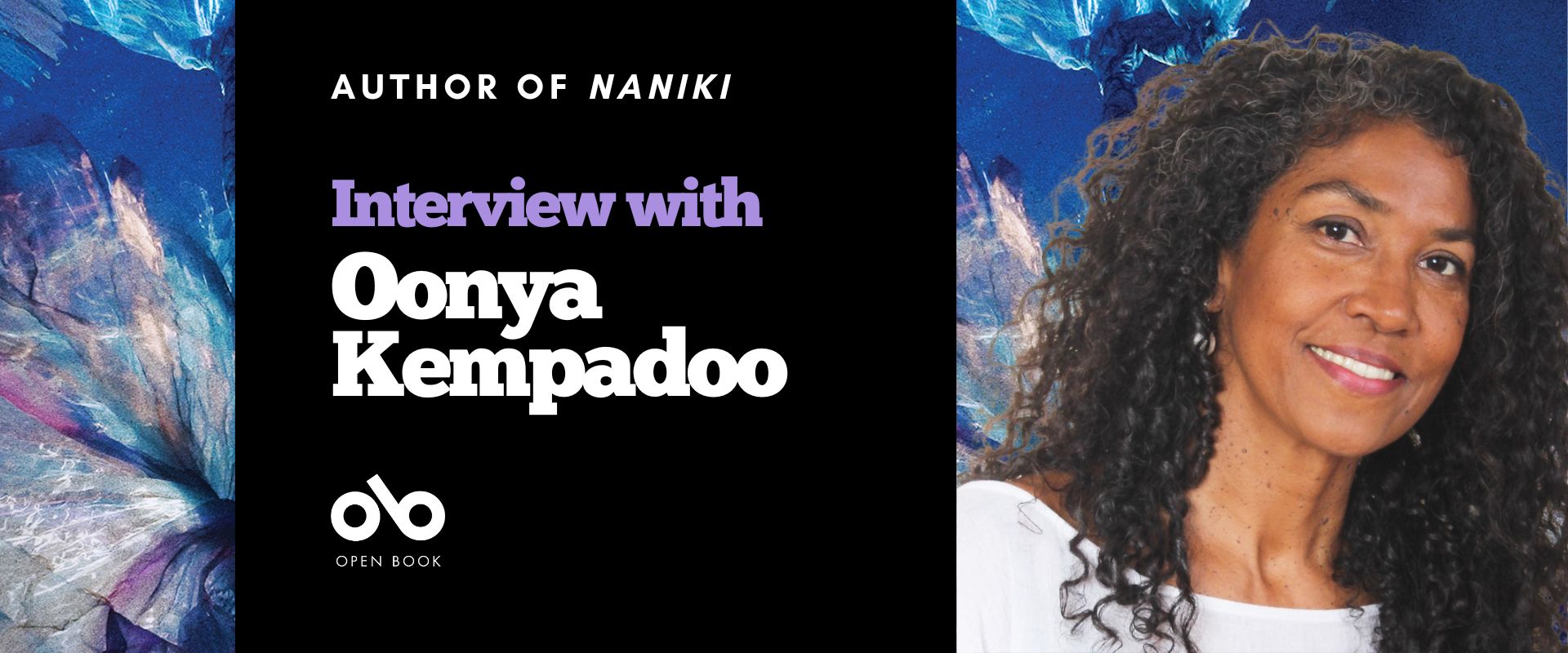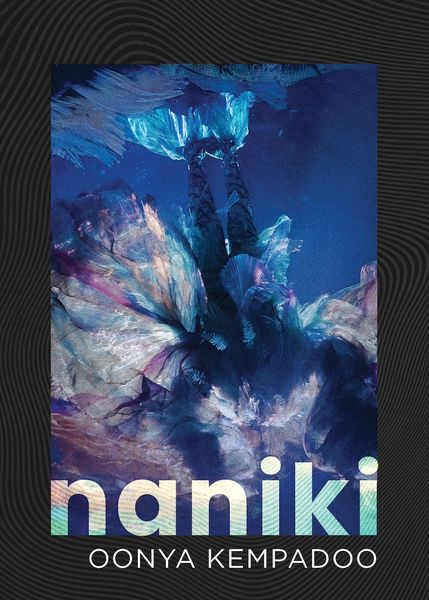Oonya Kempadoo Explores the Deep Blue of the Caribbean in Naniki
The origins and ancestry of a people are almost always tied closely to their relationship with the lands and waters around them, where they makes their lives and leave traces of themselves for future generations to find and follow. Sometimes these traces can thin and fade, and it is the work of authors and artists like Oonya Kempadoo that bring them back into bold relief.
In her new novel, Naniki (Dundurn Press/Rare Machines), Kempadoo takes us to the Caribbean Basin and follows the story of co-protagonists Amana and Skelele, elemental beings made of water and air. They have evolved and shifted shapes with their naniki (active spirits), and take on a journey to see if the future that they've pre-visioned will actually come to pass. When devastation erupts in this region, Amana and Skelele must go back in time at the behest of their ancestors and source ancient knowledge, faced with historical and mythological challenges along the way.
Today we're in conversation with Oonya Kempadoo as part of the It's a Long Story novelist interview series, where she shares the origins of the novel, and how she was inspired to write it after one fateful dip in the Caribbean Sea. What she saw that day was just the beginning, and through years of multi-form exploration and cross-cultural immersion, Kempadoo has brought forth a beautiful work about the inner workings of waters that surrounded her ancestors, and how stories have been carried through her family as the natural world shifts and changes throughout time.
Open Book:
Do you remember how your first started this novel or the very first bit of writing you did for it?
Oonya Kempadoo:
Very clearly. This story interrupted the completion of my third novel. I used to write outdoors (always longhand), by the sea, and I was taking a break. I was in the sea when I saw a pelican dive in. I followed it under and imagined it transforming – and that was the story seed. I climbed back onto the jetty and wrote it down in five pages. From there it got longer, more detailed, but it was more of an outline and treatment – for what format I didn’t know, but it didn’t feel like a novel. It was a complete story but not a novel (as I saw it then). It felt like this was a story that needed interaction somehow, and so I went on, over many years, to explore it in multimedia combining art/visuals, music, story and eventually produced it in 2023 as Naniki Immersive, a location-based experience that includes live performance.
OB:
How did you choose the setting of your novel? What connection, if any, did you have to the setting when you began writing?
OK:
You could say the setting created the story. This came from years of writing outdoors by the sea, in different spots in Tobago, and then in Grenada. It is how I first started writing, where I find my imagination, memory, and focus, is most vivid. Seascapes, from my perch on rocks, a cliff, a beach, jetty, and time in seawater (as much as I could), is connected to my writing process. And to the privilege of time to observe, internally and externally, and to putting words down on paper. It always felt like a privilege and a reminder of change – how everything changes constantly. Noticing changes around me, sea changes, shifts in the sky, on land, and underwater, crept into my writing, it became this story, it gave me story.
The elements and other life presence reoccurs in my writing, a tree as character in my first novel, the sea as a voice in my second, and a city as parallel character in my third. Nature’s setting, to me, is also a reminder of how human-centred we are in our stories too, and how much impact we have on this earth, without care. In preparing to write prose, or in responding to my ‘setting’, I began writing ‘fragments’ poetry-like bits, and these (and this story) began to feel like letters to my ‘other’, the environment.
Your CanLit News
Subscribe to Open Book’s newsletter to get local book events, literary content, writing tips, and more in your inbox
OB:
If you had to describe your book in one sentence, what would you say?
OK:
Led by shape-shifting Sea and Sky beings, it is a dreamlike swim through the Caribbean Sea, the islands, futures, the past – to find regeneration.
OB:
Did you do any specific research for this novel? Tell us a bit about that process.
OK:
It was, and continues to be, informal and organic research, following the main characters into Taino culture, Caribbean people’s origins, drawing on legends and knowledge from my childhood in Guyana. Reading, always reading, for pleasure and finding connections, deliberately on a specific topic and making notes. I have lots of old-school index card notes and references for various iterations of this story. Beginning with trying to find out more about environmental efforts in the Caribbean, I started online research, contacted organizations, and through networking and conversations, co-founded Carisealand.org to begin mapping conservation projects throughout the region. The Map on this website, thanks to Schuyler Esprit and students of the Create Caribbean Research Institute, gives open access to this type of information, which was not readily accessible then. Ecological research about marine health in the Caribbean, climate change, endangered species, is ongoing – beyond the publication of the novel - as the core concept continues its life as a story project. Collaboration with artists, in the exploration and development of multimedia called for more research and connections in various directions, music, dance, Caribbean performance arts…
OB:
What was the strangest or most memorable moment or experience during the writing process for you?
OK:
Ironically, much of this novel, when I did get around to writing it as that, was written in Montreal, far from the sea, tucked in cafes, where I never thought I could write because of the noise and people all around! And from a haven home in the city, writing this was a way of being in the Caribbean Sea and region once again, imaginary travelling, like the journey itself in Naniki. The finishing touches were completed reconnecting with the sea in Barbados, and boy, did it remind me of how odd it was to write in a city setting – but at the same time what different muscles that develops.
OB:
Who did you dedicate your novel to, and why?
OK:
It is dedicated to my mother, “my first storyteller” and my son, the “first listener” of this story. Really because my love of stories and storytelling comes from being surrounded by literature as a child and Mom’s reading, collecting, and sharing stories from Guyana, the Caribbean, Europe, India, Africa, Aboriginal tales from everywhere… It instilled a love in me for listening, reading, and learning of folktales and cultural tales, and in that way ‘travelling’ in the world and inhabiting other bodies and beings. Of course, I read a lot to my son as he grew, including bits of my first novel as I wrote that. He is a good listener and reader too and so when he responded positively to the early short form of this story, then got his friends to listen and respond too, it was my first endorsement to keep going.
OB:
What if, anything, did you learn from writing this novel?
OK:
That stories have multiple forms and lives. If you listen carefully to a story, it might demand things beyond your skills but should that put you off? This story pushed me outside of my ‘field’ as a writer of novels, into realms I am still discovering and returning to, for example performance arts. It is exciting and terrifying at the same time. Especially when everything you do now, or don’t do, the length of time it takes, your triumphs and trials, is public knowledge. I treasure the private intimacy of writing more than ever now but also love the collaboration of inter-arts storytelling.
_________________________________________
Oonya Kempadoo is the author of three novels and is critically acclaimed on both sides of the Atlantic. A creative practitioner with an interest in cross-disciplinary dialogue, she is a citizen of England, Guyana, and Grenada, and currently lives in Montreal.





